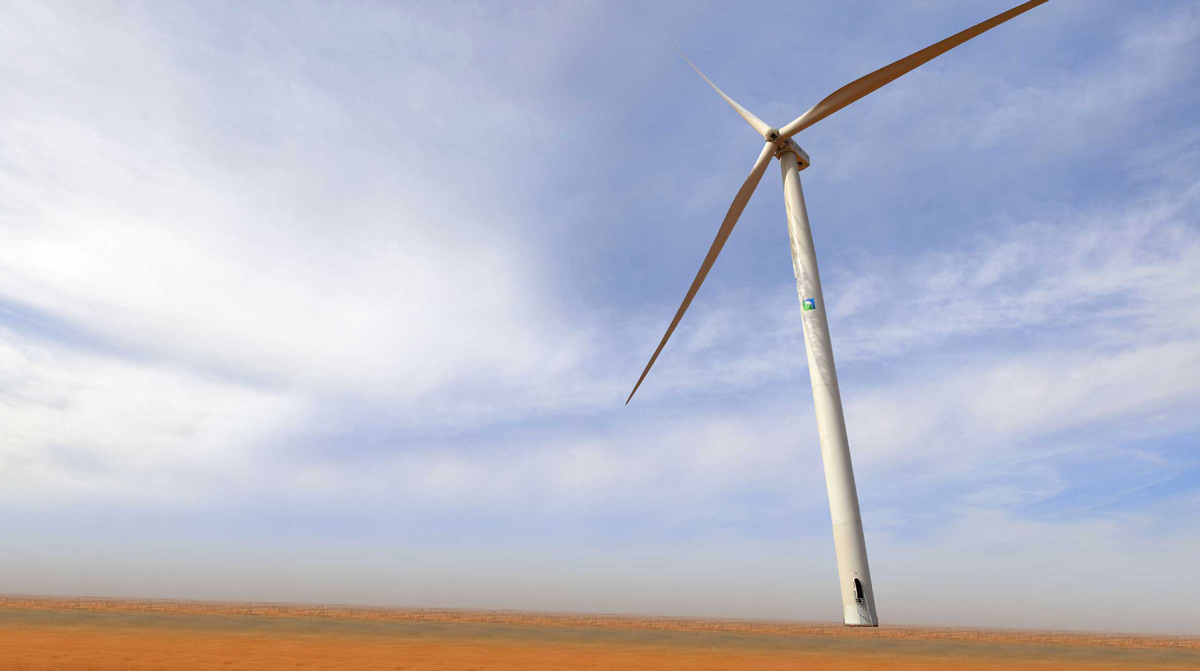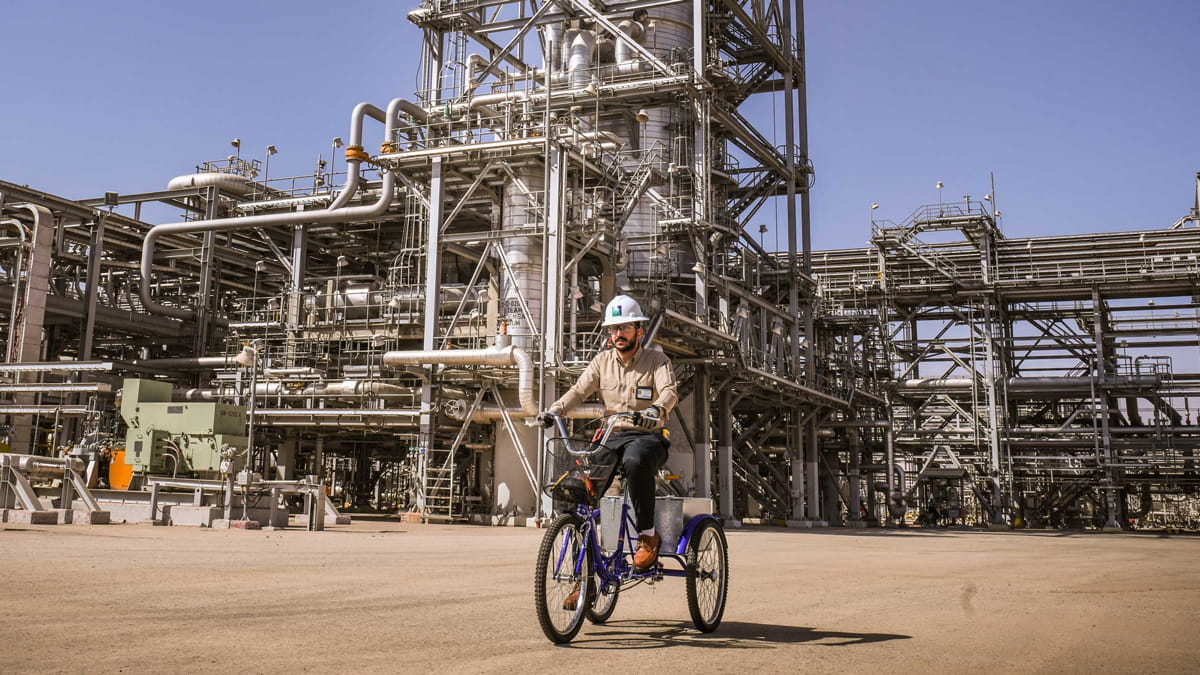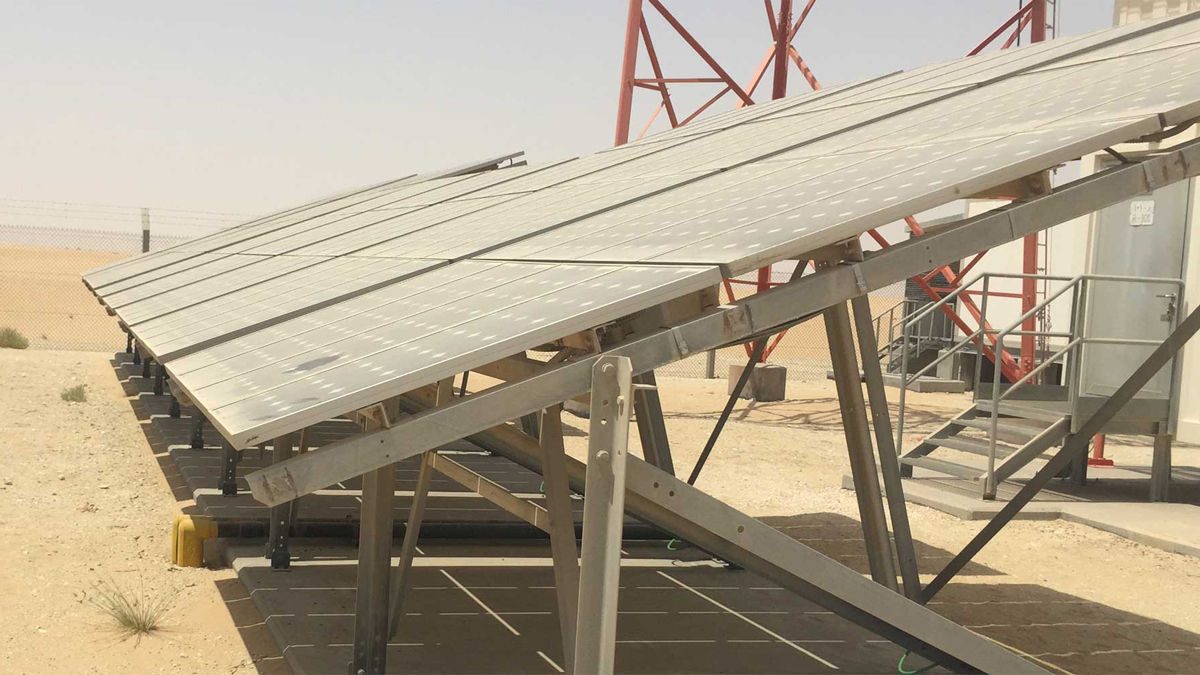Saudi Arabia is diversifying its domestic energy mix
Renewables not that new

Global July 29, 2020 - By
Used by Saudi Aramco since the 1980s as a better way to produce oil and gas.
Through the early morning shadow of a steel giant towering on Saudi Arabia’s distant eastern desert horizon, a worker effortlessly pedals an industrial bike. The shimmering ultramodern giant is one of the world’s largest oil producing facilities, and operates at Saudi Aramco’s Khurais site.
Against five 98-foot processing trains stretching quietly with graceful precision into Khurais’ empty sky, Basel M. Alenezi dismounts at Oil Train-5, and removes a pipe wrench from the three-wheeled bike’s steel toolbox to begin methodically isolating the condensate line on an oil train. At Khurais — known as an intelligent oil field — it is considered smart to use old-fashioned pedal power instead of an engine.
Meanwhile, in the Kingdom’s northwest, the sun is powering the Company’s unconventional gas wells. The goal is to save every Arabian sunbeam so the solar energy is also stored in batteries used to power remote facilities.
Green energy powering Saudi Aramco’s unconventional projects:
- Waad Al-Shammal: An industrial city northeast of Turaif on Saudi Arabia’s northern border, is powered by natural gas from Saudi Aramco.
- Jafurah: An unconventional gas field located between Ghawar, the world’s largest oil field, and the Arabian Gulf.
- South Ghawar: An unconventional gas field located south and west of the giant Ghawar oil field.
Look to the northeast, and sitting within Saudi Aramco’s busy Dhahran headquarters, a solar farm twinkles cheekily alongside the Kingdom’s first oil strike, the Prosperity Well. The farm’s 126,695 photovoltaic panels, installed in 2012, soak up enough of the sun’s rays to feed 10.5 megawatts into the power grid for the corporate and residential complexes in Dhahran.

Efficiency innovation good for business
Looking after the planet’s second largest proven crude oil reserves, Saudi Aramco is also the world’s second largest daily oil producer. As the Company goes about conscientiously extracting crude oil from the energy abundance of the Kingdom’s many and mighty oil fields, it is the world’s largest producer of crude oil and condensate.
Yet, featuring within this seemingly vast flow of crude oil is a deliberate demand for innovative energy efficiency. Limiting energy use reduces the Company’s environmental footprint, and makes for a good business case — Saudi Aramco is regarded as the world’s lowest cost oil producer.
Saudi Aramco Power Systems Renewables Department manager Muhammad Harbi says the Company’s analysis has always supported reducing wasteful energy use. “Using renewables saves precious hydrocarbon resources for better economic use, and minimizes greenhouse gas emissions,” said Harbi.
The Company’s project portfolio in renewable energy started in the 1980s when it installed 10.9 volt photovoltaic panels for a remote cathodic protection station at Shedgum, a gas plant near al-Hasa, an ancient oasis region in eastern Saudi Arabia. Some are still in operating condition.
Digital renewable twins
Nowadays, from an intelligent monitoring and diagnostic center at the Dhahran headquarters, named iPower, Saudi Aramco keeps a close monitoring and diagnostic eye on its renewable assets. Twin digital copies of the renewable system were created by combining design and historical data.
The digital twins of renewable assets analyze real-time data to predict efficiency and reliability performance. “Using advanced algorithms, gaps and mitigation actions are identified, which provides for the best performance, operation, and maintenance of Saudi Aramco’s renewable assets in the Kingdom’s harsh climate,” explains renewable engineer Wayel Oweedha.

Kingdom’s Vision 2030 strategy
Rich in sunlight and wind, as in oil and gas, Saudi Arabia is on a journey to rapidly diversify its domestic power supply by creating a global hub of renewable energy capability. This bold strategy will substantially increase the contribution of wind and solar energy in its total energy mix, liberating valuable liquid fuels, while also investing across the manufacturing value chain of renewable energy technology.
Saudi Arabia enjoys an abundance of both wind and sunshine. “North of the Red Sea and close to Egypt there is a lot of wind, and for most of the year the sun shines in the Kingdom,” says Saudi Aramco engineer Ahmed A. Sager, who worked on the Dhahran solar farm installation, and holds a master’s degree in engineering science specializing in renewable energy electrical power systems.
Sager says that as part of efforts toward addressing climate change, Saudi Arabia is promoting the concept of a circular carbon economy, which is aimed at restoring the balance of the planet’s carbon cycle through encouraging all possible climate mitigation options. The concept acknowledges that renewables are an important part of the world’s energy transition, and that the emissions from oil and gas — not the oil and gas itself — are part of the greenhouse gas problem.
“Crude oil’s amazing agility has made it an essential product for modern life, providing energy, construction and household materials, and personal items such as fabric for clothing,” said Sager. “There is no ‘one-size fits all’ solution for our planet’s dual dilemma of building a cleaner energy system plus meeting future energy demand, as well as meeting the United Nations’ goal of affordable and clean energy for all the world’s population by 2030.”
Reducing the world’s emissions, addressing energy poverty and meeting growing energy demand, is a fundamental predicament for our planet and all who inhabit it. For some time, Saudi Aramco, one of the world’s most significant oil and gas companies with abundant reserves, has embraced renewables in its energy mix.



